1. Bonds of Friendship (Kizuna) between the International Community and Japan, and “Open Reconstruction”
(1) Japan’s and the International Community’s Response to the Great East Japan Earthquake
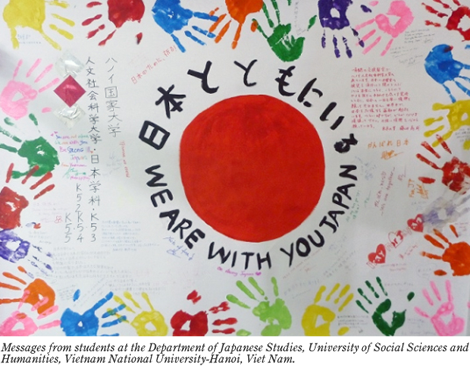 The Great East Japan Earthquake on March 11, 2011 was a historical disaster for Japan. It left more than 15,000 people dead, 3,000 missing, and 6,000 injured. The disaster, including the subsequent accident at Tokyo Electric Power Company (TEPCO)’s Fukushima Daiichi Nuclear Power Station, brought the total number of evacuees to 470,000 within three days.
The Great East Japan Earthquake on March 11, 2011 was a historical disaster for Japan. It left more than 15,000 people dead, 3,000 missing, and 6,000 injured. The disaster, including the subsequent accident at Tokyo Electric Power Company (TEPCO)’s Fukushima Daiichi Nuclear Power Station, brought the total number of evacuees to 470,000 within three days.
This disaster not only inflicted unbearable pain on those affected but also posed challenges on Japan that could have weakened its influence in the international community. However, this disaster also brought an opportunity for the people of Japan to recognize anew high esteem the world holds in Japan and strong bonds of friendship between Japan and the world are. The nobility, resilience, and discipline demonstrated by the Japanese people despite the massive damage and chaos as well as the admiration by the world for such behaviour brought confidence and pride to the Japanese people. We must never forget that many of the foreign nationals who lived in the disaster-struck area also made great contribution to rescue operations, rehabilitation, and reconstruction efforts.
Countries, regions, and organizations all over the world offered assistance and expressed their solidarity with Japan, which faced a national crisis. The governments and authorities of 163 countries and regions, and 43 international organizations offered to provide rescue teams, relief supplies, and donations. Eventually, Japan received rescue and expert teams from 24 countries/regions and five international organizations, as well as relief supplies and donations from 126 countries/regions and international organizations.1 The total scale of assistance in terms of the number of countries and people involved was much larger since private and/or non-governmental organizations and individuals contributed as well. The governments of many least developed countries (LDCs)2 also offered assistance. There were numerous cases in which elementary school pupils in low-income communities spontaneously sent their pocket money to Japanese diplomatic missions. Literally, Japan received supports from all over the world.
Such generous assistance could be attributed to relationships of mutual trust that Japan has built with countries through its efforts towards peace and stability in the world, persistent efforts in international cooperation through its Official Development Assistance (ODA) and the respect for Japanese culture and technology.
The Japanese people’s response to the disaster and the steady progress towards reconstruction have raised the international community’s expectations for and appreciation of Japan. Japan should have more confidence and pride in itself. Furthermore, Japan should not only overcome the disaster, but also make greater efforts to address global issues such as development cooperation, peacekeeping and peacebuilding, climate change, and disarmament and non-proliferation more than ever. Such efforts are not only requital for what the international community has done for Japan but also a means to build a peaceful and stable international community, which is essential for the prosperity of Japan itself.
1 See the appendix at the end for the outlines of the assistance.
2 LDC refers to a country whose three-year average estimate of gross national income per capita is less than 750 USD. A total of 25 LDCs extended assistance to Japan.
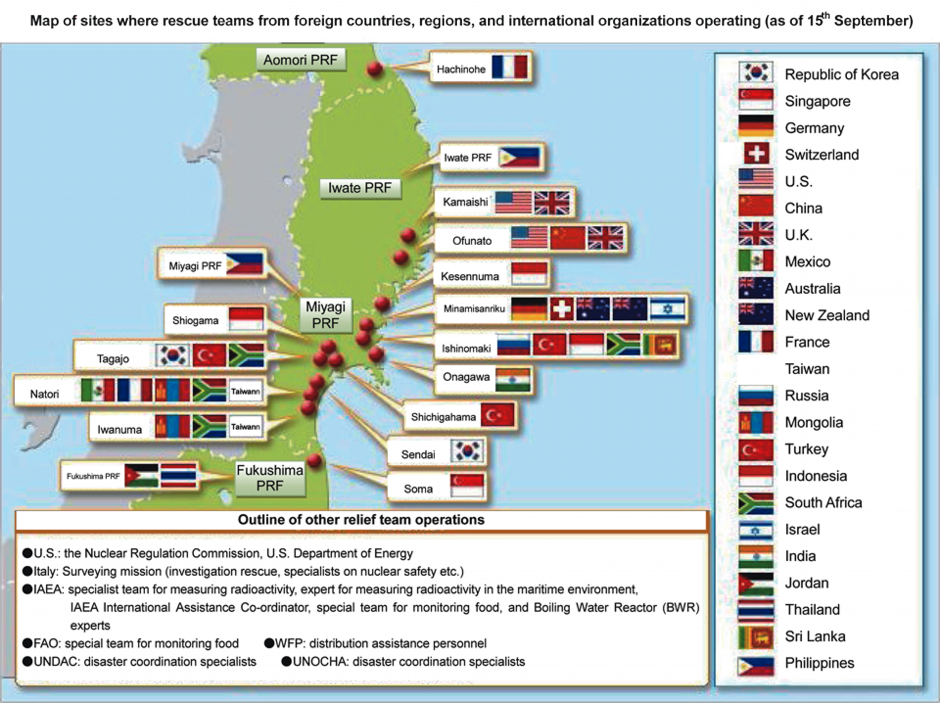
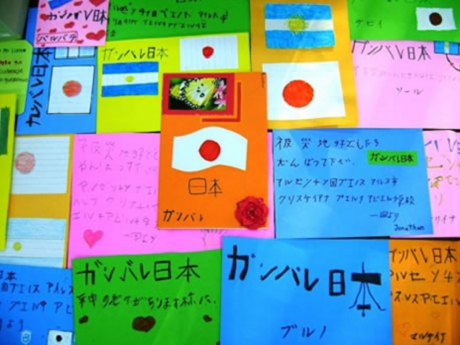
Message cards from students at Escuela Puerta Abierta (elementary and junior high schools in Argentina) sent to the Japanese Embassy.
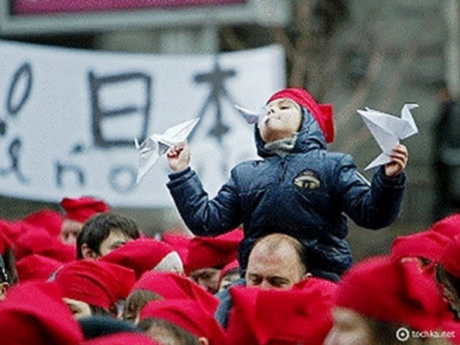
“Go for It! Japan” Campaign in Kiev, Ukraine
Selected political leaders who visited the region damaged by the Great East Japan Earthquake
| Visitor | Destination of visit | Date of the visit |
|---|---|---|
| Australian Prime Minister Julia Gillard | Minami-Sanriku Town, Miyagi Prefecture | April 23 |
| Chinese Premier Wen Jiabao and ROK President Lee Myung Bak | Affected areas and evacuation centers in Sendai, Miyagi Prefecture and Fukushima Cities, Fukushima Prefecture | May 21 |
| The U.S. President pro tempore of the United States of Senate Daniel Inoye | Sendai City, Miyagi Prefecture | June 3 |
| Indonesian President Susilo Bambang Yudhoyono and Mrs. Yudhoyono | Kesennuma City, Miyagi Prefecture | June 18 |
| The International Atomic Energy Agency Director General Yukiya Amano | TEPCO’s Fukushima Daiich Nuclear Power Plant | July 25 |
| Laotian Deputy Prime Minister and Foreign Minister Thongloun Sisoulith | Natori City, Miyagi Prefecture | August 1 |
| UN Secretary-General Ban Ki-moon | Fukushima and Soma cities, Fukushima Prefecture | August 7-8 |
| The U.S. Vice President Joe Biden | Sendai City, Miyagi Prefecture | August 23 |
| French National Assembly President Bernard Accoyer | Sendai City, Miyagi Prefecture | September 14 |
| Philippine President Benigno Aquino | Ishinomaki City, Miyagi Prefecture | September 26 |
| French Prime Minister François Fillon | Ishinomaki City, Miyagi Prefecture | October 22 |
| German President Christian Wulff | Iwaki City, Fukushima Prefecture | October 25 |
| Bhutanese King Jigme Khesar Namgyel Wangchuck and Queen Jetsun Pema Wangchuck | Soma City, Fukushima Prefecture | November 18 |
| Timor Leste President José Ramos-Horta | Sendai and Notori Cities, Miyagi Prefecture | January 20, 2012 |
(2) Open Reconstruction
Recovery from the Great East Japan Earthquake and reconstruction of disaster-hit areas remain the top priority for the Government of Japan. Warm support and solidarity offered by the international community, on the one hand, and the significant disruption of international supply chain caused by the disaster on the other, reminded us once again how closely Japan and the world are linked together. In line with one of the basic schemes stated in the “Basic Policy for Reconstruction from the Great East Japan Earthquake”, (Decision of the Reconstruction Headquarter on July 2011), as we face reconstruction, it is important, for the purpose of reconstruction process being open to the world, by reinforcing kizuna, the bonds of friendship with the international community so as to incorporate its dynamisms that is not inward-looking. The Ministry of Foreign Affairs of Japan continues its efforts to contribute to this open reconstruction in day-to-day diplomatic activities.
In this context, the Ministry of Foreign Affairs is addressing the follows; (1) continuing its utmost efforts to address measures against harmful rumors overseas, (2) promoting foreign direct investment in the disaster-hit areas and other parts of Japan utilizing schemes such as the system of Special Zone for Reconstruction, (3) promoting the acceptance of foreign nationals who may help revitalize Japan considering the fact that foreign researchers and technical experts are leaving Japan in the wake of the March 11 disaster, (4) expanding the overseas market for products from the disaster-struck areas using ODA, (5) ensuring opportunities for equal competition for Japanese businesses and products through the promotion of free trade, lastly (6) sharing the knowledge and lessons learned from the disaster and the reconstruction process with international community as international public goods. To this extent, the Government of Japan plans to host an international conference in summer 2012 regarding disaster reduction in the disaster-stricken Tohoku region to advance international cooperation in the field of disaster management which Japan regards as its vital task to carry out in the sake of having experienced one of the world’s worst disasters.
The Great East Japan Earthquake struck when Japan was already facing a “looming crisis” as was highlighted by severe financial difficulties and the decline of economic growth associated with the decreased and aging population. Japan is, as it were, in “crisis within a crisis”.
Along with these activities, Japan will pursue development of disaster-hit areas to be sustainable through managing post-disaster reconstruction. This will surely be a pioneering example of Japan’s revitalisation. Once its revitalisation being successful, Japan will be able to share this model with the international community as a lead runner in problem-solving.
2. Japan’s International Response after the Accident at Tokyo Electric Power Company’s Fukushima Daiichi Nuclear Power Station
(1) Sharing Information with the International Community
The accident at TEPCO’s Fukushima Daiichi Nuclear Power Station is an unprecedented event that no other country has ever experienced. It is unprecedented in that it was a combination of natural disasters and a nuclear accident, that the situation developed simultaneously at multiple plants, and that it lasted for a long time. Therefore, it was extremely important for Japan to provide information on the accident to the international community. Likewise, it became an important responsibility for Japan to share with the international community the knowledge and lessons learned from a thorough investigation of the accident and to contribute to strengthening nuclear safety worldwide.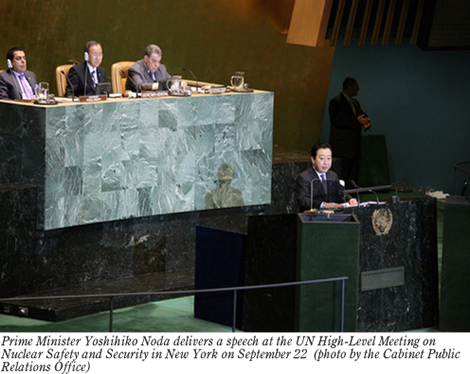
From this point of view, Japan has been actively engaged in sharing information. In particular, at the summit level, Prime Minister Naoto Kan gave explanations directly to the world leaders on such occasions as the Japan-China-ROK Trilateral Summit Meeting on May 22 and the G8 Summit 2011 in Deauville on May 26-27. Prime Minister Yoshihiko Noda also did so at the United Nations High-Level Meeting on Nuclear Safety and Security on September 22. Such explanations were also given by the Japanese side at other occasions including bilateral summit meetings and foreign ministerial meetings.
In June, Japan submitted a detailed accident report with hundreds of pages to the International Atomic Energy Agency (IAEA) Ministerial Conference on Nuclear Safety for the benefit of the international community.3 Also at the IAEA General Conference in September, Japan released a follow-up report that contained the actions taken on the lessons that had been reported in June, additional information on the accident and the progress in working to bring the accident under control.
In addition, Japan sought to deliver accurate information through its Embassies and Consulates to overseas high-ranking government officials and experts as well as through TV appearance and local media interviews with Japan’s ambassadors, press releases, microblogging and other media.4
From March 13 onward, the Government of Japan briefed the diplomatic missions in Tokyo on a daily basis with the attendance of the relevant ministries and agencies. The foreign press in Japan received daily briefings from the Prime Minister’s Office with the relevant ministries and agencies in attendance and high-ranking government officials took every opportunity including interviews to disseminate information to the foreign media. The Prime Minister’s Office, the Ministry of Foreign Affairs of Japan and its diplomatic missions, and relevant ministries and agencies continued to release the latest information on their websites.5
3 IAEA runs the Response Assistance Network (RANET) whereby competent authorities and organizations that offer assistance to the Member States register for the sharing of information and providing assistance in the case of a nuclear accident. Japan called for making the registration entries more specific and increasing the number of Member States among other proposals.
4 For a period of one month until April 11, Japan alone took a total of about 1,500 actions regarding overseas public relations in connection with the March 11 disaster. These included TV appearances, interviews, press releases, and messages from ambassadors.
5 The Ministry of Foreign Affairs posted disaster-related information on its website in four languages: Japanese, English, Chinese, and Korean. Disaster-related information is being made available in a total of 39 languages in addition to English on the websites of its diplomatic missions around the world.
(2) Proposals to the International Community Based on the Experience and Lessons Learned from the Accident
While working to settle the accident, Japan has sought to share with the international community the knowledge and lessons learned from the process.
In this context, Prime Minister Naoto Kan announced at the G8 Summit in Deauville in May that Japan would host an international conference on nuclear safety in Japan in co-sponsorship with the IAEA in the second half of 2012. In the discussions at the G8 process, IAEA and other fora, Japan made five major proposals to enhance international nuclear safety: (i) strengthening IAEA safety standards and facilitating their application; (ii) expanding the IAEA Safety Assessment Missions; (iii) expanding the IAEA registration scheme for assistance during nuclear accidents6; (iv) encouraging stronger partnership among nuclear safety regulatory authorities, and (v) strengthening the nuclear safety-related conventions. These proposals were reflected in the Action Plan on Nuclear Safety endorsed at the IAEA General Conference on September 22.
Prime Minister Yoshihiko Noda addressed the leaders’ session at the outset of the UN High-Level Meeting on Nuclear Safety and Security in New York on September 22, and Foreign Minister Koichiro Gemba co-chaired a concurrent session of the Meeting. They presented the knowledge and lessons learned from the nuclear accident in Fukushima.
(3) Assistance from the International Community
As has been mentioned in 1. (1), substantial assistance was offered from abroad in the wake of the Great East Japan Earthquake. Many countries and international organizations provided assistance to help Japan respond to the nuclear accident in Fukushima as well. This assistance included dispatching of nuclear experts and the supply of nuclear-related equipment such as large water spray pump units, remote-controlled robots, protective body armors and protective masks, radiation measuring instruments, and personal radiation dosimeters.
(4) Addressing Harmful Rumors
Following the accident at the Fukushima Daiichi Nuclear Power Station, quite a few countries and regions tightened their regulations on products imported from Japan as well as their citizens travelling to Japan. These regulations varied by countries and regions, including certificates of origin to be attached as a prerequisite, radiation testing at the customs clearance, bans on imports, and travel advisories not to visit Japan. The Ministry of Foreign Affairs of Japan, through its diplomatic missions, has examined the state of these restrictions and shared information with relevant ministries, agencies, and organizations in Japan. In the mean time, the Ministry explained the latest situation regarding Japan’s measures to regulatory authorities overseas and urged them to ease excessive regulations.
As part of efforts to revive and strengthen the Japan Brand, the Ministry has proactively disseminated information overseas on the progress of reconstruction, the allure of the Tohoku Region and other parts of Japan, and Japanese technologies and products. This was delivered through means such as overseas public relations projects, media relations, participation in tourism exhibitions with Japan booths, and publicity using photographs and videos. In Japan, the Ministry has regularly held briefing sessions for diplomatic missions and the foreign media in Tokyo, with the attendance of the relevant ministries and agencies. The Ministry, together with other ministries and agencies, organized information sessions for foreign business persons residing in Japan and organizations in Japan in cooperation with the Japan External Trade Organization (JETRO) and the Japan National Tourism Organization (JNTO).
Long-term efforts are necessary to cast away the excessive import restrictions and travel restriction and to dispel harmful rumors in major countries. To this end, the Ministry will continue to provide accurate information in a timely manner regarding the nuclear power plant and food safety to foreign governments, foreign media, and other organizations to have better understanding.
6 Japan announced a total of 28 lessons learned from the accident under five categories: (i) “strengthen preventive measures against a severe accident”; (ii) “enhancement of response measures against severe accidents”: (iii) “enhancement of nuclear emergency responses”: (iv) “reinforcement of the safety infrastructure”: and (v) “thoroughly instill a safety culture.” For the full text, see http://www.kantei.go.jp/foreign/kan/topics/201106/pdf/chapter_xii.pdf.

